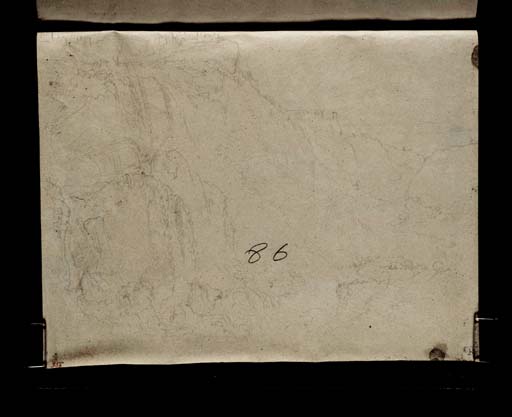Joseph Mallord William Turner The Santuario di Ercole Vincitore, Tivoli, seen from the Valley 1819
Image 1 of 2
Joseph Mallord William Turner,
The Santuario di Ercole Vincitore, Tivoli, seen from the Valley
1819
Joseph Mallord William Turner 1775–1851
Folio 1 Verso:
The Santuario di Ercole Vincitore, Tivoli, seen from the Valley 1819
D41397
Turner Bequest verso of CLXXXIII 1
Turner Bequest verso of CLXXXIII 1
Pencil and traces of grey watercolour wash on white wove paper, 200 x 253 mm
Inscribed by ?John Ruskin in red ink ‘356’ bottom left, and by an unknown hand in pencil ‘86’ lower centre
Inscribed by ?John Ruskin in red ink ‘356’ bottom left, and by an unknown hand in pencil ‘86’ lower centre
Accepted by the nation as part of the Turner Bequest 1856
Turner’s exploration of Tivoli included a large number of landscape sketches drawn from the river valley to the north. He was particularly attracted by the spectacle of the town’s ancient ruins perched above the steep, wooded gorge and streaming waterfalls. This study depicts the view looking south from the floor of the valley towards the Ponte Acquoria. On the left-hand side are the cascatelli (or cascatelle), the lesser cascades caused by a branch of the River Aniene emerging from an underground passage at the top of the slopes at the northern tip of the town. Silhouetted in the central middle distance are the long arcades of the Santuario di Ercole Vincitore (Sanctuary of Hercules the Victor), a first-century BC Roman temple dedicated to the cult of Hercules.
Formerly known as the Villa of Maecenas, the Santuario di Ercole Vincitore was one of Tivoli’s most famous landmarks. Its picturesque qualities were described by Revd John Chetwode Eustace who, in A Classical Tour Through Italy, first published in 1813, recommended the view from the opposite side of the valley:
As the traveller, following the bend of the hill, comes to the side of the road opposite to the town, he catches first a side glimpse, and shortly after a full view of the Cascatelli, or lesser cascades, inferior in mass and grandeur, but equal in beauty to the great fall in the town. They are formed by a branch of the Anio turned off from the main body of the river, before it reaches the precipice, for the uses of the inhabitants, and after it has crossed the town bursting from a wood on the summit of the hill, and then tumbling from its brow in one great and several lesser streams, first down one and then another declivity, through thickets and brambles spangled with dew drops or lighted up with a rainbow. The elevation and mass of these cascades; the colours and broken masses of the rocks down which they tumble; the shrubs, plants and brambles that hang over the channel and sometimes bathe themselves in the current; the river below fretting through a narrow pass under a natural arch; the olives that shade that arch, and the vines that wave around it; the bold bendings and easy sweeps of the surrounding mountains; and the towers of the town rising on the top of the hill beyond the cascade, with the ruins of Maecenas’s villa on its shelving side, form one of the most delicious pictures for softness and beauty, wildness and animation, that can be imagined.1
Turner made notes on this passage in the Italian Guide Book sketchbook (see Tate D13952; Turner Bequest CLXXII 11a). He would also have been familiar with other artists’ depictions of the temple. Compositional precedents for the view include John ‘Warwick’ Smith (1749–1831), Villa of Mecenas, an engraved plate from the publication Select Views in Italy, which Turner copied in the Italian Guide Book sketchbook (see Tate D13966; Turner Bequest CLXXII19), and a watercolour by John Robert Cozens (1752–1797), which Turner studied as a young man, see Tivoli, Villa of Maecenas, after John Robert Cozens ?circa 1794–7 (Huntington Library, Art Collections and Botanical Gardens, San Marino, California). Compare also a contemporaneous drawing by James Hakewill (1778–1843), Villa of Maecenas and Cascatelle. Tivoli 1816 (British School at Rome Library), engraved for Hakewill’s Picturesque Tour of Italy, published in 1819.2
The temple features in many of Turner’s 1819 sketches looking both up and down the valley, and he also made detailed tonal studies of the architecture and the arched passageway underneath the ruin’s substructures, see folio 5 (D15471). It was the vista from the north-east however, which seems to have held the greatest visual appeal. A similar view can be found on folio 3 (D15469), as well as in the Tivoli and Rome sketchbook (D15013–D15014, D15018, D15025, D15029–D15030; Turner Bequest CLXXIX 46 verso–7, 48 verso, 53 verso, 55 verso–56), and in the Naples: Rome C. Studies sketchbook (Tate D16120–D16121; Turner Bequest CLXXXVII 32–3). Turner later considered developing the prospect for the Tivoli vignette illustration for Rogers’s Italy, 1830 (see Tate D27605; Turner Bequest CCLXXX 88), and ultimately revisited it within an oil sketch, Tivoli, the Cascatelle circa 1827–8 (Tate, N03388) and an unfinished painting, Tivoli: Tobias and the Angel circa 1835 (Tate, N02067).3
Nicola Moorby
February 2010
Tony Cubberley and Luke Herrmann, Twilight of the Grand Tour: A Catalogue of the drawings by James Hakewill in the British School at Rome Library, Rome 1992, no.5.3, p.226, reproduced.
How to cite
Nicola Moorby, ‘The Santuario di Ercole Vincitore, Tivoli, seen from the Valley 1819 by Joseph Mallord William Turner’, catalogue entry, February 2010, in David Blayney Brown (ed.), J.M.W. Turner: Sketchbooks, Drawings and Watercolours, Tate Research Publication, December 2012, https://www


